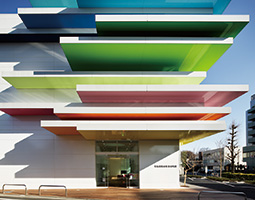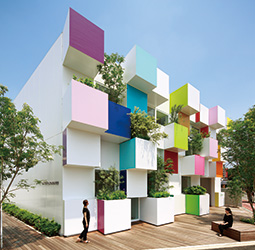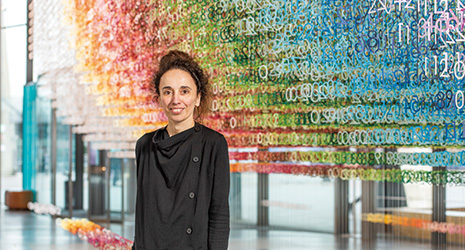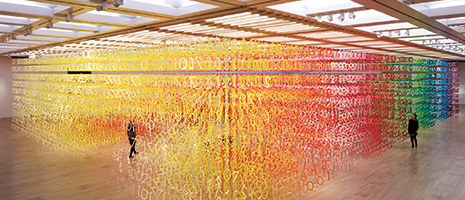INDEX


Moureaux’s representative works include the architectural design for branches of Sugamo Shinkin Bank
July 2020
Shikiri: Dividing Space with Colors

Emmanuelle Moureaux moved to Japan from her native France in 1996 after being amazed by the complex layers of color filling the streets of Tokyo. As an architect, artist and designer, she seeks to communicate through her creations the same such feelings of joy and wonder that colors can inspire.

“Colors give people energy. They put smiles on people’s faces.”
These are the words of Emmanuelle Moureaux, who creates installations with “color” as their main theme for locations in Japan and around the world. Installations in whatever their medium must interact with the location or exhibit space itself. Moureaux typically achieves this by composing space using color as her medium. Her representative works include an installation series called 100 colors in which she defines space by the use of multiple layers and combinations of brightly colored materials such as cloth or paper. The materials are typically cut into large geometric shapes or may take the form of numbers (Forest of Numbers), hiragana characters (Universe of Words) and other three-dimensional designs. The works are often suspended from the ceiling and hang and sway like noren dividing curtains. Each installation takes “100 colors” as its motif but is created in response to the time and place.
Moureaux says that her inspiration for creating such works comes from the Tokyo townscape.
“I studied architecture at a French university and came to Japan since the theme of my thesis was ‘Tokyo.’ What I first saw of the streets of Tokyo was endless layers of countless colors in three dimensions. It was completely different from the orderly French townscapes that have perspectives focusing the gaze on one point. I still can’t forget the emotion. It was as if I saw color for the first time.”
Not even an hour into her stay in Tokyo, Moureaux had decided that she would live in Japan, and so she moved to Tokyo in the following year of 1996, became a registered architect with a first-class license in Japan in 2003, and opened her office, emmanuelle moureaux architecture + design.
Since the beginning of her activities in Japan, Moureaux’s concept has been shikiri, her own neologism combining shiki (color) and shikiri (partition), which literally means “dividing space with color.”


“Once I moved to Tokyo, I noticed that color is almost never used in Japanese modern architecture and design,” Moureaux explains. “Japanese traditional architecture, which partitions spaces with sliding screens and sliding paper doors and which I thought was an excellent culture, is disappearing. Shikiri was my solution for incorporating these two essences and recommunicating them to the modern world.”
Moureaux demonstrated this concept in one of her representative works at six branches of the Sugamo Shinkin Bank. In all of them, “color” was not simply a finishing accent but an important component of the building. The stores have a colorful façade design and an indoor open space that also doubles as an urban rest area, making them designs that upturn the conventional wisdom of Japanese bank architecture as well as new landmarks that are both pleasant for the people working inside and easy to like for the people living in the town.
“I use a lot of colors in my works, but when I make something to last in a town, I pay special attention not only to the surrounding environment but also to the meaning and message of the work,” Moureaux says.
One example is the public artwork mirai, which she made for the new block Green Springs in Tachikawa City, Tokyo in 2020. It is an ambitious piece that uses 100 colors to visualize a 100-year future, taking one color for each year from 2020 to 2119. It blends in with its surroundings and immediately moves people’s hearts.
“We spend our lives surrounded by so many colors, but I think we almost never pay special attention to ‘color,’” says Moureaux. “I am creating my works with the desire that many people will feel the same emotion I felt when I came to Tokyo for the first time.”
Moureaux’s many works of impressive urban coloring are sure to keep demonstrating how “color” inspires rich emotion in us.

